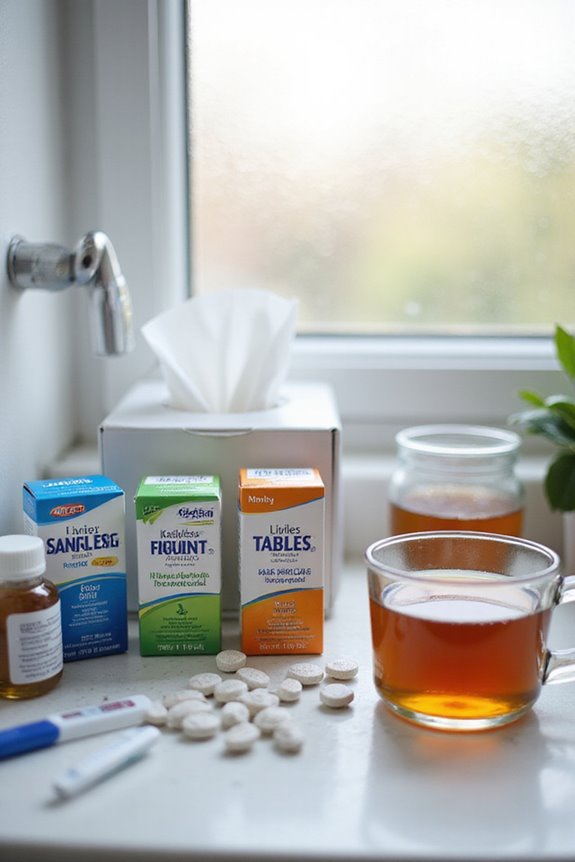To choose the right cold and flu remedy, evaluate specific symptoms and available ingredients. Influenza symptoms include high fever, severe fatigue, and a dry cough. Key active ingredients include acetaminophen, ibuprofen, and decongestants. Nasal sprays can reduce illness duration by 20%. Antiviral medications, like oseltamivir, are effective when taken within 48 hours of symptom onset. It is essential to reflect on safety and potential side effects, particularly for those with underlying health issues. Further insights on treatment options are available.
Key Takeaways
- Assess symptoms: Identify if you have a cold or influenza based on onset, fever, cough severity, and fatigue levels.
- Choose appropriate ingredients: Select remedies with acetaminophen for fever, guaifenesin for cough, and chlorpheniramine for runny nose.
- Consider nasal sprays: Use effective over-the-counter nasal sprays to reduce illness duration and trap respiratory droplets within 48 hours of symptom onset.
- Consult antiviral options: If symptoms are severe, consider prescription antivirals like oseltamivir or baloxavir for effective treatment within the first 48 hours.
- Be aware of side effects: Understand potential risks associated with NSAIDs and other ingredients, especially if you have pre-existing health conditions.
Understanding Your Symptoms
Understanding the onset and progression of symptoms is essential for differentiating between a cold and influenza.
Symptom Comparison
- Onset Timing: Influenza symptoms appear suddenly, typically two days post-exposure, while cold symptoms develop gradually over 2 to 3 days.
- Fever: High fever (over 100°F) is common in influenza; colds typically involve no or low-grade fever.
- Cough: Influenza causes a severe, dry cough lasting up to two weeks; colds produce a mild hacking cough.
- Fatigue: Severe fatigue is prominent with influenza, whereas colds result in only mild tiredness.
Active Ingredients and Their Functions

Active ingredients in cold and flu remedies play a pivotal role in symptom management. Understanding these components is essential for effective treatment.
Analgesics and Fever Reducers
- Acetaminophen: Reduces fever and relieves minor aches.
- Aspirin: Offers pain relief; not recommended for children.
- Ibuprofen: Provides anti-inflammatory effects.
- Naproxen: Another NSAID for pain and fever.
Cough Suppressants
– Dextromethorphan HBr: Reduces cough reflex, beneficial for dry coughs.
Expectorants
– Guaifenesin: Loosens phlegm, improves cough productivity.
Nasal Decongestants
– Phenylephrine HCl and Pseudoephedrine HCl: Relieve nasal congestion.
Antihistamines
– Chlorpheniramine maleate: Alleviates runny nose and sneezing.
These active ingredients guarantee targeted symptom relief, guiding individuals in selecting appropriate remedies.
Evaluating Nasal Spray Options

When evaluating nasal spray options, what criteria should consumers prioritize to guarantee effective symptom management?
Nasal Spray Efficacy
- Over-the-counter nasal sprays can reduce illness duration by approximately 20%.
- Some formulations neutralize over 99.99% of viruses and bacteria in nasal cavities.
Barrier Properties
- Effective sprays coat the nasal cavity, trapping respiratory droplets and forming a robust gel barrier.
- This barrier delays pathogen entry, reducing the risk of upper respiratory infections.
Timing and Use
- Iota-Carrageenan nasal sprays are most effective when used within 48 hours of symptom onset.
- Frequent use is generally well-tolerated, making nasal sprays a viable option during cold and flu seasons.
Selecting a nasal spray with proven efficacy and protective barrier properties can enhance overall health outcomes.
Prescription Antiviral Medications

Prescription antiviral medications play a critical role in the management of influenza, particularly when initiated promptly after the onset of symptoms.
Types and Usage
- Baloxavir marboxil (Xofluza): Approved for ages 12+, a single oral dose.
- Oseltamivir (Tamiflu): Approved for over 2 weeks old, effective for treatment and prevention.
- Peramivir (Rapivab): IV single dose, approved for ages 6 months+.
- Zanamivir (Relenza): Inhaled, approved for ages 7+.
Antiviral Effectiveness
- Most effective within 48 hours of symptom onset.
- Dosage recommendations vary by medication; consult a healthcare provider for personalized guidance.
Considerations
– Monitor for side effects, particularly in high-risk populations. Early intervention optimizes recovery and minimizes complications.
The Role of Decongestants

How do decongestants alleviate symptoms of nasal congestion during colds or allergies? Decongestants operate through a specific mechanism of action, stimulating the autonomic nervous system to mimic adrenaline, leading to blood vessel constriction. This process reduces swelling in nasal turbinate tissues, enhancing airflow.
Decongestant Types:
- Oral Decongestants: Pseudoephedrine is effective, while oral phenylephrine has been deemed ineffective at common dosages.
- Topical Nasal Decongestants: Nasal sprays act rapidly, shrinking blood vessels with fewer systemic effects.
Safety Considerations:
- Decongestants can elevate blood pressure; individuals with hypertension should exercise caution.
- Short-term use of topical options is advisable to avoid rebound congestion. Always consult healthcare providers for best selection based on health status.
Combination Medications and Their Use
Combination medications are formulated to address multiple symptoms of cold and flu, offering a convenient solution for individuals experiencing a range of discomforts. These products enhance combination effectiveness by combining active ingredients such as acetaminophen, ibuprofen, cough suppressants, and antihistamines.
Key considerations include:
- Ingredient Interactions: Overlapping components can lead to toxicity if multiple medications are taken simultaneously.
- Product Selection: Evaluate specific symptoms before use; single-ingredient remedies are often preferable for isolated issues.
- Recommendation: Physicians and pharmacists frequently endorse these products as effective and cost-efficient for multi-symptom relief.
While generally safe when used correctly, awareness of ingredient interactions is essential to optimize treatment and minimize risks.
Safety and Side Effects to Consider
When evaluating cold and flu remedies, safety and potential side effects warrant careful consideration. Adhering to safety precautions is essential, particularly for those with preexisting conditions.
Cardiovascular Risks:
- NSAIDs may increase heart attack and stroke risks, particularly in individuals with cardiovascular disease.
- Phenylephrine and pseudoephedrine can elevate blood pressure and cause irregular heartbeats.
Gastrointestinal and Urinary Side Effects:
- Up to 1% may experience nausea, vomiting, or abdominal discomfort from NSAIDs and dextromethorphan.
- Phenylephrine can lead to dysuria and urinary retention.
Neuropsychiatric Effects:
– Dizziness, drowsiness, and anxiety are possible, albeit rare.
Awareness of these side effect profiles informs safer use, particularly in vulnerable populations, ensuring informed choices when selecting remedies.
When to Seek Professional Advice
Determining the appropriate moment to seek professional advice regarding cold or flu symptoms is critical for effective management. Individuals should consider the following indicators:
- Symptom Duration: Symptoms persisting beyond 10 days may suggest a bacterial infection requiring antibiotics.
- Worsening Symptoms: Sustained high fever (above 102°F/39°C) or severe sore throat with painful swallowing necessitates medical evaluation.
- Difficulty Breathing: Signs such as chest pain or wheezing demand immediate attention.
- Complications: Development of yellow or green phlegm could indicate pneumonia.
High-risk groups, including those with chronic medical history, young children, and elderly patients, should seek advice promptly. Monitoring symptom progression and severity is essential for appropriate care. Early intervention can prevent complications and lead to better health outcomes.
Frequently Asked Questions
Can I Use Multiple Remedies at Once?
Using multiple remedies at once can lead to interactions between remedies, raising concerns about the safety of combinations. It is vital to check ingredient labels and consult healthcare professionals to guarantee effective and safe treatment.
How Long Should I Take Cold Medications?
Duration recommendations for cold medications typically suggest a maximum of 7 days. Adhering to dosage guidelines is essential to avoid complications, ensuring safe and effective relief from symptoms while monitoring any changes in condition.
Are Home Remedies Effective for Cold and Flu?
The effectiveness of home remedies for cold and flu varies. While some herbal remedies may provide symptom relief, scientific support is limited. Staying hydrated, resting, and using steam inhalation are generally more reliable approaches for comfort.
Should I Avoid Certain Foods While Sick?
Like traversing a stormy sea, one should steer clear of certain foods while sick. High-fat, sugary, and irritating options can hinder digestive health, leaving the body adrift in discomfort and prolonging recovery.
How Can I Prevent Catching a Cold or Flu?
To prevent catching a cold or flu, individuals should adopt effective handwashing techniques and explore immune-boosting practices. Engaging in community health efforts fosters a sense of belonging while promoting collective well-being and reducing illness spread.





